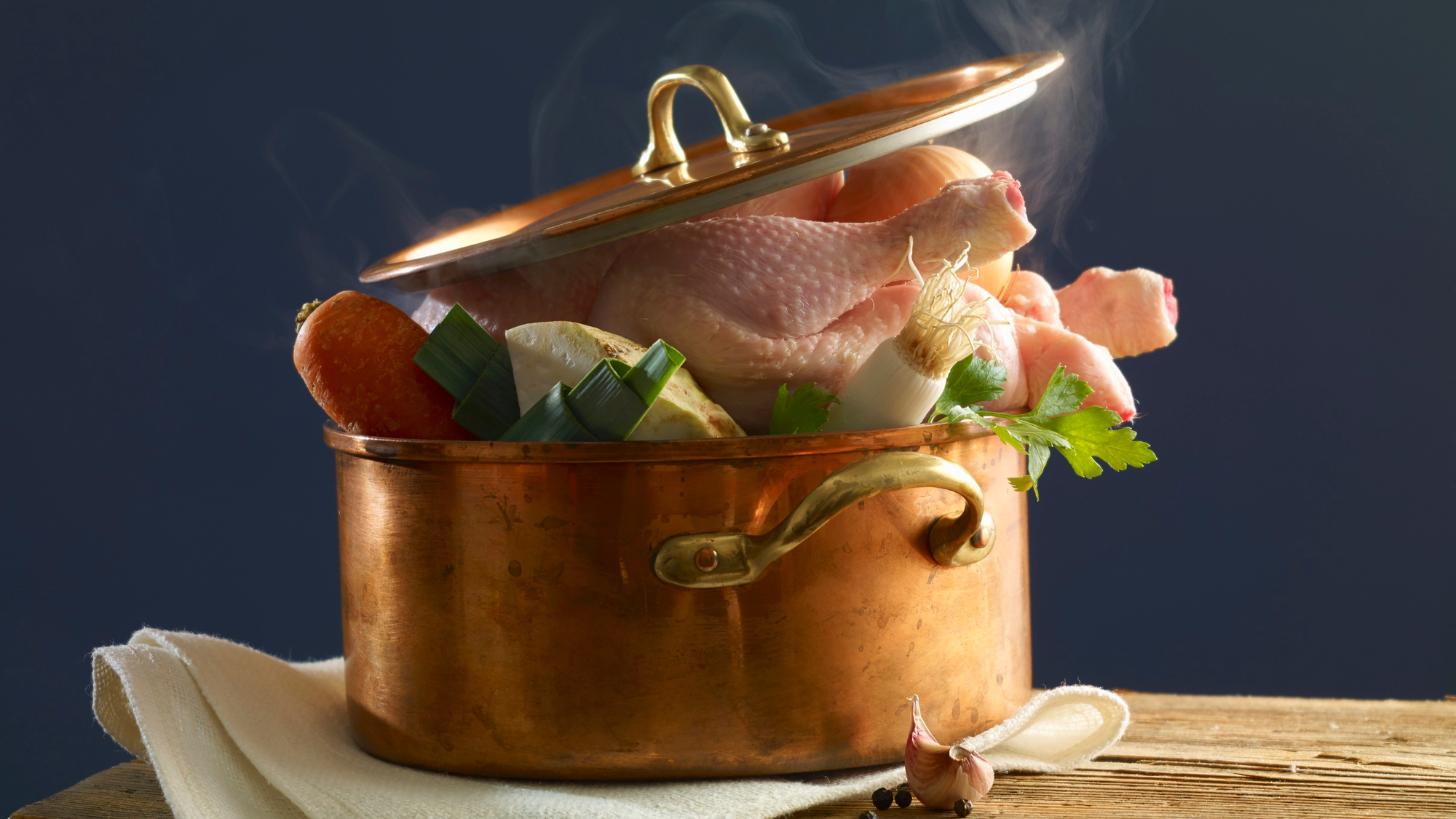Homemade Chicken Stock Separates Great Home Cooks From The Good
We may receive a commission on purchases made from links.
I traditionally go for any shortcut I can find in the kitchen. But lately, I've found that the quickest route may not necessarily be the best. I have learned hard lessons about Pillsbury pie crusts and Minute Rice compared to their homemade counterparts. But my latest conquest, even I was dubious about.
I've also mentioned that my husband has taken to cooking over the past few years, and one of his innovative projects I just could not get behind. Namely: making homemade broth. I reason, if the Swanson's people are nice enough to perfect their own seasonings and give us convenient broth in cans, and now in handy cartons, who are we to go to the grocery store and ask for the stuff they're throwing out in order to create our own stock?
As is Takeout editor Kevin Pang's newly indoctrinated tradition, he suggested that I try for myself. Make my own chicken stock. My main beef (ha) with making my own stock is that I really am not a fan of carcasses or anything that indicates that what I just ate used to be alive. Bones, sinew, gizzards, ick. Yet, these discarded innards were going to be the main ingredients of the stock from the recipe in the book Kevin lent me, Ratio: The Simple Codes Behind The Craft Of Everyday Cooking. Author Michael Ruhlman could not have been more emphatic about homemade stock without getting straight-up evangelical about it: "If there's one preparation that separates a great home cook's food from a good home cook's food, it's stock."
So we bought a rotisserie chicken at the grocery, pulled off all the meat, and made a chicken pot pie for dinner (using a leftover pie crust from a previous self-improvement project! See, it all comes together). The next day, noting that the recipe suggested a cook time of two to six hours, I worked from home, kicking off my day as I tossed the carcass in a Dutch oven, covered with water, and kept at continual steaming but not boiling temperature for several hours.

After those hours had passed, the recipe suggested adding a number of spices "if, and only if, you happen to have them available." Mister, you are obviously not familiar with the random assortment in my kitchen. We always have garlic and tomato paste and cracked black pepper available. So while not a straight-up mirepoix, I tossed some seasonings in there, and simmered for another hour.
Once the stock was strained, we conducted a family taste test, which was a completely unfair battle. As one of my all-time favorite movies puts it, "and then came the dawn." Placed side by side, the homemade stock wiped the mat with store-bought. Said one of my testers, the paler stock "didn't taste like anything." It did, actually: water-flavored water, with a dash of salt.

Like with the pie crust, like with the rice, using this recipe is certainly more complicated than the easier method of opening up a carton of broth. But the results are definitely rich enough to be worth it. Why, right now my husband is using the stock I made to create a fortified stock, which is stock created using stock, for a cassoulet.
What could be next on this self-improvement journey of mine? The way things are going, I'll probably be squashing my own wine grapes or roasting my own pig before summer is over. In the meantime, when the occasion arises, I will certainly take the few moments to toss a carcass in a Dutch oven to make a fairly easy and clearly superior chicken stock. As a bonus: Your house will smell amazing for several hours.
Recipe from Ratio: The Simple Codes Behind The Craft Of Everyday Cooking
- Bones from a 3- to 4-pound chicken, along with any meat still on the carcass (or any baked/rotisserie chicken bones totaling 1 to 1 1/4 pounds)
- 2 carrots
- 1 Spanish onion
- Kosher salt to taste
- Optional: a teaspoon of black peppercorns, a bay leaf, some parsley sprigs, stems of thyme, a few cloves of garlic, leek tops, a tablespoon of tomato paste—any or all of these items only enhance the finished stock if, and only if, you happen to have them available
Cut or pull the chicken carcass into pieces so that it fits into a 2-quart pot. Cover the bones with cold water. Put them over very low heat for 2 to 6 hours, just enough to keep the water heated to 180 or 190 degrees Fahrenheit (but not simmering). Add the remaining ingredients and cook for another hour over low heat. Strain into a clean pan or a 1-quart container.
